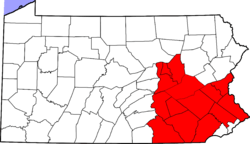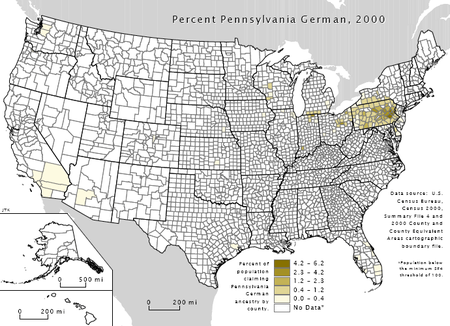Pennsylvania Dutch Country
Pennsylvania Dutch Country, also called the Deitscherei in Deitsch, refers to an area of southeastern Pennsylvania, United States that by the American Revolution had a high percentage of Pennsylvania Dutch inhabitants. Religiously, there was a large portion of Lutherans. There were also German Reformed, Moravian, Amish, Mennonite, Schwarzenau Brethren and other German Christian sects. The term was used in the middle of the 20th century as a description of a region with a distinctive Pennsylvania Dutch culture, but in recent decades the composition of the population is changing and the phrase is used more now in a tourism context than any other.
Greater Pennsylvania refers to this region as well as historically Pennsylvania Dutch-speaking areas of Maryland, North Carolina, and Virginia.[1]

Geography
Geographically the area referred to as Amish/Dutch country centers on the cities of Allentown, Hershey, Lancaster, Reading, and York. Pennsylvania Dutch Country encompasses the counties of Chester, Lancaster, York, Adams, Franklin, Dauphin, Lebanon, Berks, Montgomery, Bucks, Northampton, Lehigh, Schuylkill, Snyder, Union, Juniata, Mifflin, Huntingdon, Northumberland, and Centre. Pennsylvania Dutch immigrants would spread from this area outwards outside the Pennsylvania borders between the mountains along river valleys into neighboring Maryland (Washington and Frederick counties), West Virginia, New Jersey (Warren and northern Hunterdon counties), Virginia (Shenandoah Valley), and North Carolina. The larger region has been historically referred to as Greater Pennsylvania. The historic Pennsylvania Dutch diaspora in Ontario, Canada has been referred to as Little Pennsylvania.
The area lies in the Piedmont region of the Appalachian mountains. The landscape is marked by rolling, wooded hills, deep stream valleys, and fertile soils. The Susquehanna River bisects the region and provides its drainage.
History

The term "Dutch" is from an archaic sense of the English word "Dutch", which once referred to any people speaking a non-peripheral continental West Germanic language on the European mainland.[2] The German-speaking settlers came from a variety of countries and religious backgrounds, but most became assimilated to Anglo-American language and culture beginning in the later 19th century with English language evangelism efforts and the outlawing of German language schooling. The assimilation process continued soon after the turn of the 20th century with World War I, consolidated schools, and the advent of mandatory public education until the age of 16, with added pressures from increased mobility, the influence of English-language media, communications, and urbanization. Also, many German-Americans hid their ethnicity with the spread of Anti-German sentiment and negative propaganda against the German people.
Originally, the economy of the region was almost entirely rural and agricultural, based on the immigrants' dream of bettering their lot through the ownership of their own farms. The small tradesmen indispensable to a rural economy, such as blacksmiths, wheelwrights, millers, and storekeepers, constituted the bulk of the non-farm economy. In the 19th century, a small educated class, comprising the Lutheran and Reformed ministers, began to emerge. The Pennsylvania seminaries educated them in high German, so they could preach to their flocks in a scholarly way.
The advent of the industrial revolution brought technologies based on coal, iron, canals, and railroads, but the Dutch, unversed in English, and lacking connections to the English-speaking establishment, were unable to engage in entrepreneurship on a large scale. Consequently, the large-scale enterprises which came to characterize the industrialized eastern half of the region, such as the Lehigh Coal and Navigation Company (marketer of the coal branded "Old Company's Lehigh"), the Lehigh Valley Railroad, and the Bethlehem Iron Company (later known as Bethlehem Steel) were founded by English speaking residents from the Philadelphia and New York areas. These English speakers (referred to by the Dutch as simply "the English") dominated the managerial and engineering positions of these companies, while the Dutch supplied the blue collar and supervisory workforce.
As technology advanced during the late 19th century, higher technology companies such as Mack Truck and New Jersey Zinc moved to the region as well. As the local industries expanded, immigrants from Middle Europe (primarily Slovakia, Poland, and Hungary) were recruited for the low-skilled positions, while the more established Dutch retained the skilled blue collar and supervisory positions. The Dutch influence on the shop floor was so great that some Slavic immigrants became bilingual in their native language and in Pennsylvania Dutch, while not yet mastering English.
Today
In the 20th century, however, universal public education in English and relatively easy access to higher education erased many of the elements that made the Pennsylvania Dutch Country a distinctive region of the United States. The information age and globalization greatly reduced the dependence of the region on industrial jobs. The Eastern part of the region (Northampton, Lehigh, and Berks Counties) is now dominated by information-intensive white collar employment.
The western counties of the region experienced industrialization as well, with Hershey Foods being the most notable example, but it was less intensive, and agriculture retained a larger share of the economy. In the middle of the 20th century, both Amish and non-Amish entrepreneurs began to promote the area as a tourist destination. Though there are still plenty of Amish attempting to follow their traditional way of life, tourism and population growth have significantly changed the appearance and cultural flavor of the area. The region is within 50 miles of Philadelphia, Baltimore, Maryland, and Harrisburg, Pennsylvania, and has not escaped the effects of being located on the western edge of the East Coast conurbation which stretches from Washington, D.C. to New York City.
The Old Order Amish and Old Order Mennonites, who have resisted these urbanization efforts most successfully, have retained aspects of their 18th century way of life, including the Deitsch dialect; however, these groups have changed significantly in the last two hundred years. Nevertheless, for the Old Order groups, change has come slower, and gradually they have become more and more distinctively different as the surrounding rural and urban population of Pennsylvania has changed.
See also
Notable locations
- Bird-in-Hand, Pennsylvania
- Blue Ball, Pennsylvania
- Clinic for Special Children
- Intercourse, Pennsylvania
- Paradise, Pennsylvania
- Ronks, Pennsylvania
Nearby attractions
- Dutch Wonderland, an amusement park
- Gettysburg National Military Park (nearby)
- Limestone Inn Bed and Breakfast listed in the National Register of Historic Places
- Railroad Museum of Pennsylvania
- Strasburg Rail Road, a steam locomotive-driven heritage railway
- Susquehannock State Park
External links
- Pennsylvania Dutch Convention & Visitors Bureau
- Hiwwe wie Driwwe - The Pennsylvania German Newspaper
References
- ↑ Steven M. Nolt. Foreigners in their own land: Pennsylvania Germans in the early republic. p. 13.
- ↑ Weaver, Kyle R. (2006), Meet Don Yoder Dean of Folklife Scholars, Pennsylvania Heritage, vol. 32, no. 2, p.9–10
Coordinates: 40°02′59″N 76°15′17″W / 40.04969°N 76.25473°W